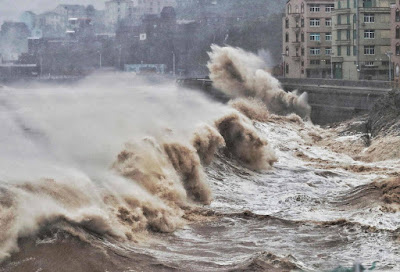At least forty four people have died after Typhoon Lekima made landfall in Zhejiang Province, China, at about 1.00 am local time on Saturday 10 August 2019. The majority of the fatalities happened in a single incident, in Yongjia County, when a landslide caused by heavy rains temporarily dammed a swollen river; when the floodwaters overcame the dam a wave of water ten metres high ploughed into a village of 120 people, causing numerous deaths. Landslides
are a common problem after severe weather events, as excess pore water
pressure can overcome cohesion in soil and sediments, allowing them to
flow like liquids. Approximately 90% of all landslides are caused by
heavy rainfall. The Typhoon caused a number of fatalities elsewhere in Zhejiang and Shandong provinces, as well as flooding across much of East China, Taiwan and the southern Ryukyu Islands.
Rescue workers search through the remains of a village in Yongjia County, Zhejiang Province, that was hit by a flash flood after a landslide caused by Typhoon Lekima temporarily blocked a river. AFP.
Tropical storms are caused by the warming effect of the Sun over
tropical seas. As the air warms it expands, causing a drop in air
pressure, and rises, causing air from outside the area to rush in to
replace it. If this happens over a sufficiently wide area then the
inrushing winds will be affected by centrifugal forces caused by the
Earth's rotation (the Coriolis effect). This means that winds will be
deflected clockwise in the northern hemisphere and anti-clockwise in the
southern hemisphere, eventually creating a large, rotating Tropical
Storm. They have different names in different parts of the world, with
those in the northwest Pacific being referred to as typhoons.
Despite the obvious danger of winds of this speed, which can physically blow people, and other large objects, away as well as damaging buildings and uprooting trees, the real danger from these storms comes from the flooding they bring. Each drop millibar drop in air-pressure leads to an approximate 1 cm rise in sea level, with big tropical storms capable of causing a storm surge of several meters. This is always accompanied by heavy rainfall, since warm air over the ocean leads to evaporation of sea water, which is then carried with the storm. These combined often lead to catastrophic flooding in areas hit by tropical storms.
See also...
Follow Sciency Thoughts on Facebook.








